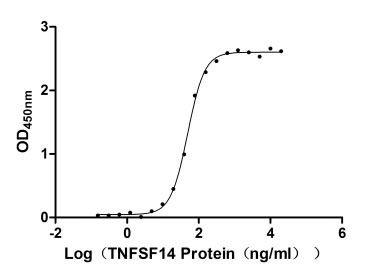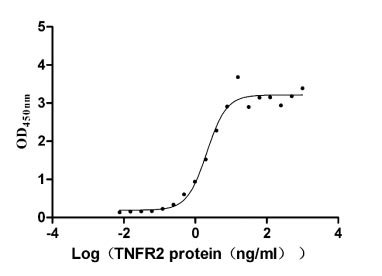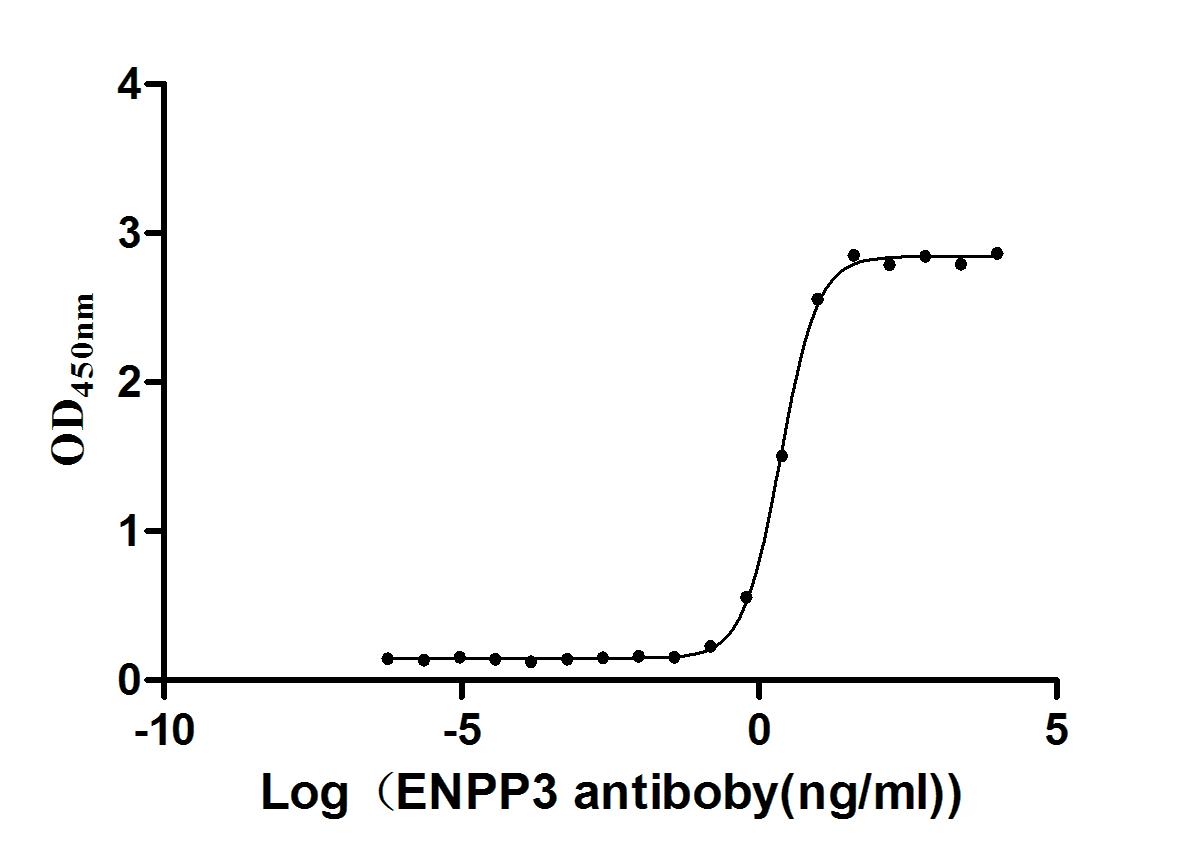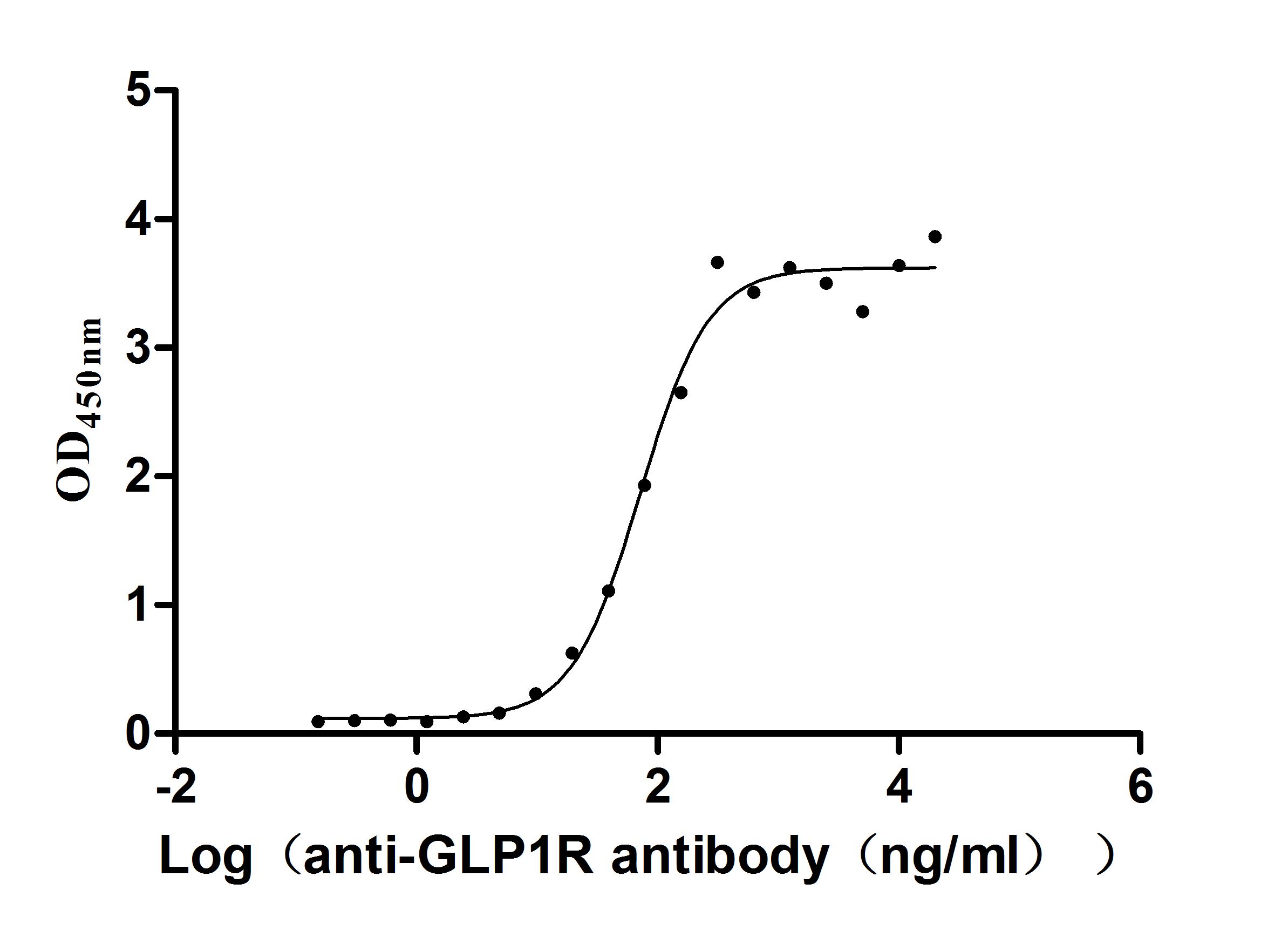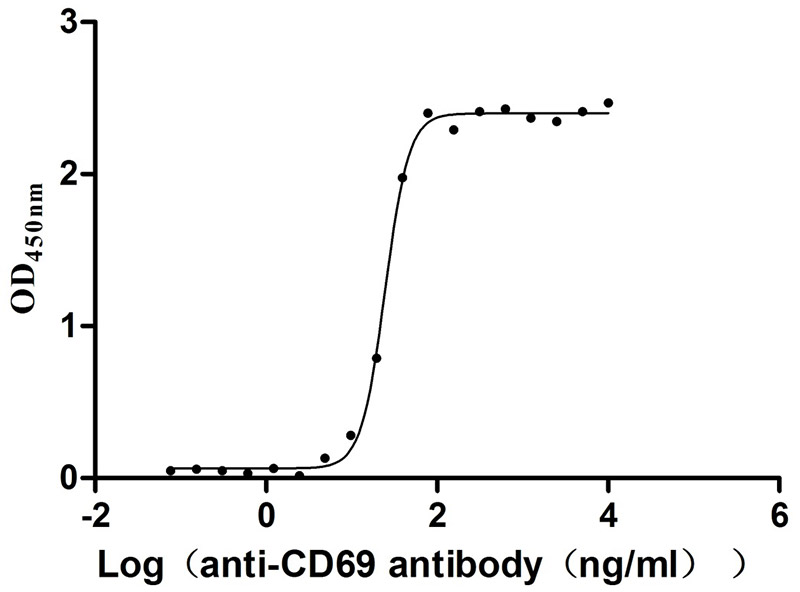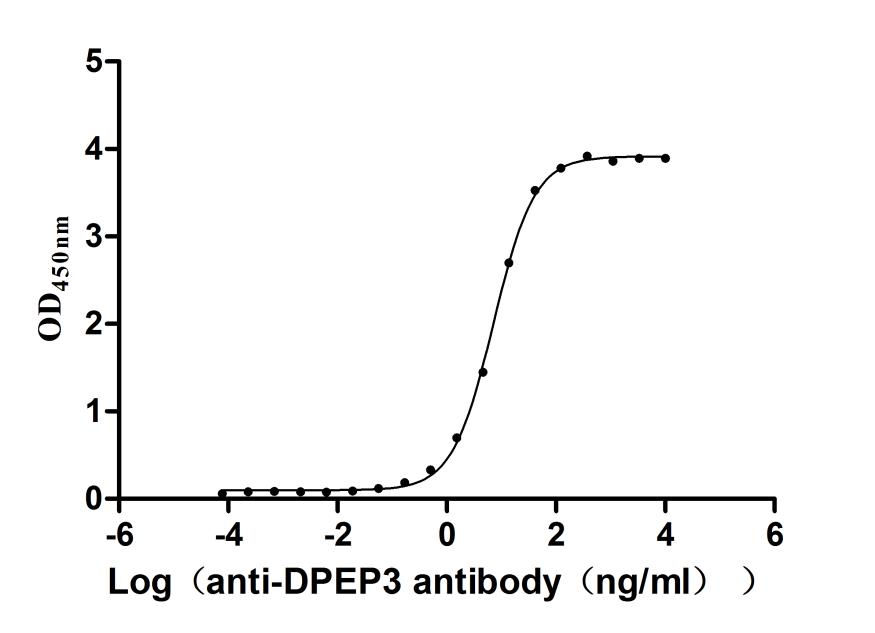Recombinant Rat Cellular tumor antigen p53 (Tp53)
-
中文名稱:大鼠Tp53重組蛋白
-
貨號:CSB-YP024077RA
-
規格:
-
來源:Yeast
-
其他:
-
中文名稱:大鼠Tp53重組蛋白
-
貨號:CSB-EP024077RA
-
規格:
-
來源:E.coli
-
其他:
-
中文名稱:大鼠Tp53重組蛋白
-
貨號:CSB-EP024077RA-B
-
規格:
-
來源:E.coli
-
共軛:Avi-tag Biotinylated
E. coli biotin ligase (BirA) is highly specific in covalently attaching biotin to the 15 amino acid AviTag peptide. This recombinant protein was biotinylated in vivo by AviTag-BirA technology, which method is BriA catalyzes amide linkage between the biotin and the specific lysine of the AviTag.
-
其他:
-
中文名稱:大鼠Tp53重組蛋白
-
貨號:CSB-BP024077RA
-
規格:
-
來源:Baculovirus
-
其他:
-
中文名稱:大鼠Tp53重組蛋白
-
貨號:CSB-MP024077RA
-
規格:
-
來源:Mammalian cell
-
其他:
產品詳情
-
純度:>85% (SDS-PAGE)
-
基因名:
-
Uniprot No.:
-
別名:Tp53; P53; Cellular tumor antigen p53; Tumor suppressor p53
-
種屬:Rattus norvegicus (Rat)
-
蛋白長度:full length protein
-
表達區域:1-391
-
氨基酸序列MEDSQSDMSI ELPLSQETFS CLWKLLPPDD ILPTTATGSP NSMEDLFLPQ DVAELLEGPE EALQVSAPAA QEPGTEAPAP VAPASATPWP LSSSVPSQKT YQGNYGFHLG FLQSGTAKSV MCTYSISLNK LFCQLAKTCP VQLWVTSTPP PGTRVRAMAI YKKSQHMTEV VRRCPHHERC SDGDGLAPPQ HLIRVEGNPY AEYLDDRQTF RHSVVVPYEP PEVGSDYTTI HYKYMCNSSC MGGMNRRPIL TIITLEDSSG NLLGRDSFEV RVCACPGRDR RTEEENFRKK EEHCPELPPG SAKRALPTST SSSPQQKKKP LDGEYFTLKI RGRERFEMFR ELNEALELKD ARAAEESGDS RAHSSYPKTK KGQSTSRHKK PMIKKVGPDS D
-
蛋白標簽:Tag?type?will?be?determined?during?the?manufacturing?process.
The tag type will be determined during production process. If you have specified tag type, please tell us and we will develop the specified tag preferentially. -
產品提供形式:Lyophilized powder
Note: We will preferentially ship the format that we have in stock, however, if you have any special requirement for the format, please remark your requirement when placing the order, we will prepare according to your demand. -
復溶:We recommend that this vial be briefly centrifuged prior to opening to bring the contents to the bottom. Please reconstitute protein in deionized sterile water to a concentration of 0.1-1.0 mg/mL.We recommend to add 5-50% of glycerol (final concentration) and aliquot for long-term storage at -20℃/-80℃. Our default final concentration of glycerol is 50%. Customers could use it as reference.
-
儲存條件:Store at -20°C/-80°C upon receipt, aliquoting is necessary for mutiple use. Avoid repeated freeze-thaw cycles.
-
保質期:The shelf life is related to many factors, storage state, buffer ingredients, storage temperature and the stability of the protein itself.
Generally, the shelf life of liquid form is 6 months at -20°C/-80°C. The shelf life of lyophilized form is 12 months at -20°C/-80°C. -
貨期:Delivery time may differ from different purchasing way or location, please kindly consult your local distributors for specific delivery time.Note: All of our proteins are default shipped with normal blue ice packs, if you request to ship with dry ice, please communicate with us in advance and extra fees will be charged.
-
注意事項:Repeated freezing and thawing is not recommended. Store working aliquots at 4°C for up to one week.
-
Datasheet :Please contact us to get it.
相關產品
靶點詳情
-
功能:Acts as a tumor suppressor in many tumor types; induces growth arrest or apoptosis depending on the physiological circumstances and cell type. Involved in cell cycle regulation as a trans-activator that acts to negatively regulate cell division by controlling a set of genes required for this process. One of the activated genes is an inhibitor of cyclin-dependent kinases. Apoptosis induction seems to be mediated either by stimulation of BAX and FAS antigen expression, or by repression of Bcl-2 expression. Its pro-apoptotic activity is activated via its interaction with PPP1R13B/ASPP1 or TP53BP2/ASPP2. However, this activity is inhibited when the interaction with PPP1R13B/ASPP1 or TP53BP2/ASPP2 is displaced by PPP1R13L/iASPP. In cooperation with mitochondrial PPIF is involved in activating oxidative stress-induced necrosis; the function is largely independent of transcription. Prevents CDK7 kinase activity when associated to CAK complex in response to DNA damage, thus stopping cell cycle progression. Induces the transcription of long intergenic non-coding RNA p21 (lincRNA-p21) and lincRNA-Mkln1. LincRNA-p21 participates in TP53-dependent transcriptional repression leading to apoptosis and seems to have an effect on cell-cycle regulation. Regulates the circadian clock by repressing CLOCK-ARNTL/BMAL1-mediated transcriptional activation of PER2.
-
基因功能參考文獻:
- These findings reveal a novel regulatory mechanism of ROCK1/p53/NOXA signaling in modulating cardiomyocyte apoptosis in vitro and maternal diabetes-induced congenital heart defects in vivo. PMID: 28131915
- these findings indicated that miR31a5p is involved in hypertension via the accelerated proliferation of arterial smooth muscle cells and inhibition of apoptosis through targeting TP53. PMID: 29620173
- Study revealed initial downregulation in the expression of p53 protein during breast cancer development. However, with progression towards malignancy, upregulation of p53 was observed. These changes were associated with polymorphism in p53 gene, which was detected in exon 5. PMID: 29498408
- Compared with the saline Hepatocellular carcinoma (HCC)-group, transplantation with CD34+ human hematopoietic stem cells produced a further increase in the levels of wnt4 (+19.4%) and p53 gene expression (+53%), a 2-fold increase in the percentage of cancer progenitor cells and increased HCC pathology grading PMID: 29429512
- The results indicate that the miR-188-3p-MDM2-p53 axis may have a critical role in sevoflurane-induced cognitive dysfunction. PMID: 29344658
- MiR-31a-5p protects cardiomyocytes against angiotensin II-induced apoptosis by targeting Tp53. PMID: 29286111
- Results suggest that Delta40p53 can be generated by a 20S proteasome-mediated post-translational mechanism so as to control p53 function. PMID: 28885617
- The results suggested that caveolin1 may be involved in nucleus pulposus cellular senescence during oxidative stress in vitro, mainly via the p53/p21 signaling pathway. PMID: 29039595
- our results revealed that the upregulation of p53 and possibly other anti-oncogenes may provide a potential effective therapeutic strategy for malignant pheochromocytoma PMID: 29048679
- over-expression of p53 could mediate oligodendrocyte apoptosis thus resulting in demyelination in two ways; by enhancing ER-mitochondria interaction and by triggering the E2F1 mediated apoptosis pathway. PMID: 28237798
- Effect of polydatin on expression of p53 and Notch1 in brain tissue of ischemic cerebrovascular disease. PMID: 29504377
- pharmacological inhibition of ATM kinase (KU55933) reduced activation of ATM kinase, but not p53, suggesting that HG-mediated activation of p53 and ATM could represent independent pro-apoptotic events..these data indicate that sustained activation of Rac1-p38MAPK signaling axis leads to activation of p53 leading to beta-cell dysfunction under the duress of chronic hyperglycemic conditions PMID: 28220272
- JNK/p53 pathway might play a critical role in the tubular cell apoptosis induced by -MCPD 1-palmitate. PMID: 27008853
- the Ras/Raf/Erk signals contribute to neuronal death through the phosphorylation of p53 in hippocampus after subarachnoid hemorrhage. PMID: 26497030
- Hypoxia and hyperoxia differentially control proliferation of rat neural crest stem cells via distinct regulatory pathways of the HIF1alpha-CXCR4 and TP53-TPM1 proteins PMID: 28002632
- This study determined if dietary restriction (DR) protects against hypoxic-ischemia (HI) in the neonatal brain via insulin receptor substrate-1 (IRS-1)/Akt pathway-mediated downregulation of p53 in the neurovascular unit. PMID: 26111627
- Results suggest that the cancer-inhibitory activity of sodium butyrate and its derivatives on liver carcinogenesis may be attributed to retention of p53 and CRM1 proteins in the nucleus, an event that may trigger activation of p53-mediated apoptotic cell death in neoplastic cells. PMID: 27013579
- The Fischer model is more consistent with the early onset of bone and central nervous system sarcomas found in humans with germline Tp53 mutations. PMID: 27528400
- findings reveal a novel function of p53 in controlling inflammatory responses and suggest that p53 abnormalities in rheumatoid arthritis could sustain and accelerate synovial inflammation PMID: 27881147
- mammalian SOS response is characterized by an increase in the p53 gene with activation of multiple DNA repair genes that harbor p53 response elements in their promoters. PMID: 28800961
- Doxorubicin (Dox)-administration to cardiomyocytes increased the levels of reactive oxygen species (ROS) in a time-dependent manner that followed the activation of stress-induced proteins p53, p38 and JNK MAPKs, culminating in an increase in autophagy and apoptosis markers. PMID: 28678856
- ANXA1 interacts with p53 and promotes p53 transcriptional activity, which in turn regulates Bid expression. PMID: 27584794
- transformed MSCs express high levels of a p53 mutant that loses the ability to bind survivin gene PMID: 27046449
- an Ntv-a transgenic rat colony was established and used to study glial brain tumors driven by two well-characterized oncogenic gene transformations, PDGFA overexpression and p53 depletion. Combined PDGFA and p53 alterations resulted in large, heterogeneous tumors in all affected animals PMID: 28358926
- MEG3 could interacted with p53 and regulated its expression, and p53 exerted significant binding in the promoters for NOX4, suggesting that MEG3 regulated NOX4 expression via p53. PMID: 28634073
- The miR-34a/SIRT1/p53 signaling pathway is activated in hepatocytes but not hepatic stellate cells during liver fibrosis PMID: 27387128
- MDM2 is involved in fibroblast activation, mediating renal tubulointerstitial fibrosis via a p53-independent pathway dependant on Notch1 ubiquitination and proteasome degradation. PMID: 28100501
- These data indicates that Drp1 mediates compression-induced programmed necrosis of NP cells by promoting mitochondrial translocation of p53 and nuclear translocation of AIF. PMID: 28411026
- Formononetin prevents cisplatin-induced acute kidney injury by targeting Oct2/TP53 in the kidney. PMID: 28414026
- Alloxan-induced renal damage is associated with alterations of p53, TGF-beta1, and extracellular matrix metalloproteinases. PMID: 28220578
- Taken together, these results indicated that ALA protected dopaminergic neurons against MPP+induced neurotoxicity through its ability to upregulate the DNA repair protein, PCNA, via the P53 pathway. PMID: 27665784
- SIRT1 attenuates cerebral ischemia/reperfusion-induced injury by targeting the p53/microRNA-22 axis. PMID: 27878231
- Cholesterol regulates bone marrow mesenchymal stem cell senescence by modulating cell cycle, autophagy, and the ROS/p53/p21(Cip1/Waf1) signaling pathway. PMID: 27703600
- results suggest that dysregulation of miR-30c and miR-181a may be involved in upregulation of p53-p21 pathway in diabetes induced cardiac hypertrophy. PMID: 27221738
- miR-449 regulates the SIRT1/p53/BAX pathway, which may be its possible mechanism in modulating cell apoptosis of cisplatin-induced Acute kidney injury. PMID: 26968221
- In conclusion, Cabin1 expression significantly increases during podocyte injury. Knockdown of Cabin1 induces p53 expression decrease in cultured podocyte. Cabin1 may provide a new target to investigate podocyte injury. PMID: 26400065
- p53 regulates autophagic activity in senescent rat mesenchymal stromal cells. PMID: 26792455
- This indicates that MPP+-induced oxidative damage is mediated by the downregulation of PCNA through the p53 pathway in a cellular model of Parkinson's disease . PMID: 26677001
- The results of the present study therefore indicated that resveratrol protected H9c2 cells from DOX-induced apoptosis via the AMPK/P53 pathway PMID: 26675978
- Hypoxia response element Bcl2 inhibition can effectively attenuate hypoxia-induced apoptosis resistance in pulmonary microvascular endothelial cells by downregulating Bcl2 expression and upregulating caspase-3 and P53 expression. PMID: 26456506
- Study suggested that neonatal bronchopulmonary dysplasia caused impaired cognitive function and neuron apoptosis in hippocampus via p53 and HIF-1alpha PMID: 26431790
- miR-23a binds to p53 and enhances its association with miR-128 promoter PMID: 26553132
- Hydrogen-rich saline is able to protect against AKI after liver transplantation partly by reducing apoptosis, which is possibly involved in the modulation of p53-mediated autophagy. PMID: 26714124
- These results suggest the existence of a causal link between Cox-2 and p53, which may represent a toxic mechanism of electrophilic lipid peroxidation products. PMID: 25506925
- Autoimmune Optic Neuritis Is Associated with Altered APP Cleavage in Neurons and Up-Regulation of p53 PMID: 26426258
- findings show p53 is activated in astrocytes during ischemia and that inhibition of the activity of this molecule prevents not only oxygen-glucose deprivation-induced neuronal and astrocytic death but also astrocyte activation and impaired glutamate uptake PMID: 26302161
- CHIP stabilizes amyloid precursor protein via proteasomal degradation and p53-mediated trans-repression of BACE1. PMID: 25773675
- Phosphorylation of p53 by LRRK2 induces p21(WAF1/CIP1) expression and apoptosis. PMID: 26384650
- Diabetes upregulates p21(CIP1/Waf1) signaling in testicular germ cells in association with alteration in p-p53ser315 expression, probably to counteract DNA damage-induced cell death. PMID: 24828139
- Our results also suggest that chromothripsis primarily occurs under p53 heterozygous rather than p53 null conditions. PMID: 25811670
顯示更多
收起更多
-
相關疾病:p53 is found in increased amounts in a wide variety of transformed cells. p53 is frequently mutated or inactivated in many types of cancer.
-
亞細胞定位:Cytoplasm. Nucleus. Nucleus, PML body. Endoplasmic reticulum. Mitochondrion matrix. Cytoplasm, cytoskeleton, microtubule organizing center, centrosome.
-
蛋白家族:P53 family
-
數據庫鏈接:
Most popular with customers
-
Recombinant Human Tumor necrosis factor ligand superfamily member 14 (TNFSF14), partial (Active)
Express system: Mammalian cell
Species: Homo sapiens (Human)
-
Recombinant Human Lymphotoxin-alpha (LTA) (Active)
Express system: Mammalian cell
Species: Homo sapiens (Human)
-
Express system: Mammalian cell
Species: Homo sapiens (Human)
-
Recombinant Human Glucagon-like peptide 1 receptor (GLP1R), partial (Active)
Express system: Mammalian cell
Species: Homo sapiens (Human)
-
Recombinant Human Early activation antigen CD69 (CD69), partial (Active)
Express system: Mammalian cell
Species: Homo sapiens (Human)
-
Recombinant Human Dipeptidase 3(DPEP3), partial (Active)
Express system: Mammalian cell
Species: Homo sapiens (Human)


